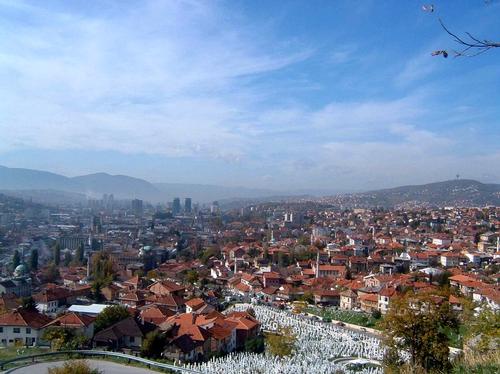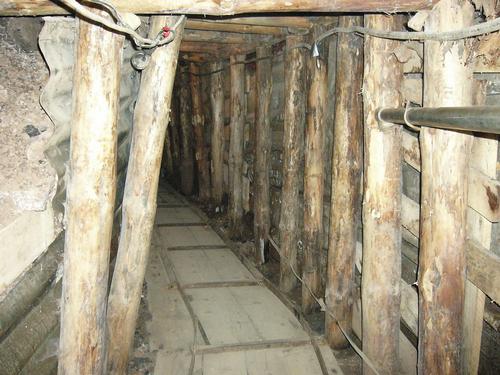BOSNIA AND HERZEGOVINA
Sarajevo

Sarajevo
Sarajevo
A wonderful mix of historic Ottoman buildings and imposing Habsburg features, "that is how Sarajevo, the capital of Bosnia and Herzegovina, can best be described. The city is full of history. Sarajevo was the start of the First World War and the city occupied an important position in the Yugoslav era.
 SarajevoPhoto:Asim Led CC 3.0 Unported no changes made
SarajevoPhoto:Asim Led CC 3.0 Unported no changes made
Location
Sarajevo is the capital of Bosnia and Herzegovina and is located in the center of the country. The city is located on two rivers: the Miljacka and the Bosna. Sarajevo is located in a valley 500 meters above sea level and surrounded by five mountains belonging to the Dinaric Alps. Sarajevo covers 142 km² and has about 403,000 inhabitants.
Weather
Sarajevo has a moderate continental climate. This means that the summers are warm and the winters cool. Precipitation falls all year round. Due to its location between five high mountains, the weather in Sarajevo is less affected by the sea. This leads to higher temperatures than in other parts of Bosnia and Herzegovina, especially in summer. In the winter months the average temperature is slightly below freezing and in the summer months it is an average of 20 degrees.
History
Sarajevo was officially put on the map by the Ottomans in 1461. At that time several buildings were built in the city, such as a mosque and a bathhouse, which gave Sarajevo prestige. At the end of the 16th century, Sarajevo had grown into one of the most modern cities in Europe.
In the course of the 17th century, a downward trend set in due to the battles waged by the Ottoman Empire. To make matters worse, the plague broke out at the end of the 18th century and the city was hit by a fire in 1788. In 1914 during the Habsburg period, Sarajevo was briefly the center of Europe, when Archduke Frans Ferdinand was murdered there. This was the start of the First World War.
 Sarajevo around 1900PHoto: Public Domain
Sarajevo around 1900PHoto: Public Domain
After World War I, Bosnia and Herzegovina became part of the Kingdom of Yugoslavia, but during World War II, the country joined the independent state of Croatia. Sarajevo had a large Jewish community before the war, but after World War II there was hardly anything left of this.
After the war, Sarajevo became the capital of the republic of Bosnia and Herzegovina as part of Yugoslavia. Industry flourished and the city expanded. Sarajevo regained its important position. This can also be seen from the fact that the 1984 Winter Olympics were held in Sarajevo.
In 1992 Bosnia and Herzegovina became an independent country again with Sarajevo as its capital. However, the Yugoslav army did not just give up and laid siege to the city for three years. More than 12,000 people were killed and an immense number of injuries were injured. In addition, much cultural heritage was irreparably destroyed. Only in 1995 did all the violence end and reconstruction work began in Sarajevo.
Sights
The Latin bridge over the Miljacka River is one of the remains of Sarajevo's Ottoman times. It is one of the oldest sights. The first bridge on this site will have been built around 1514 and was made of wood. In 1565 a stone bridge was replaced, which was restored after a flood in 1791. At the north end of the bridge, Frans Ferdinand was murdered by Gavrilo Princip in 1914.

Latin Bridge SarajevoPhoto: Baumi CC 3.0 Unported no changes made
The Roman Catholic Sacred Heart Cathedral is also worth a visit. The design of this church is taken from nothing less than Notre-Dame in Paris. The church was built between 1884 and 1889. During the siege of Sarajevo, the cathedral was seriously damaged, but has been completely restored.
 Tunnel SarajevoPhoto: Elias Bizannes CC 2.0 Generic no changes made
Tunnel SarajevoPhoto: Elias Bizannes CC 2.0 Generic no changes made
A visit to the Tunnel Museum is very special. Here you get an impression of what life must have been like during the siege of Sarajevo, one of the blackest pages in modern European history. The tunnel ran under the UN-owned airport to the besieged city, bypassing the Serbian encirclement. The tunnel was used to smuggle food, weapons and medicine into the city and injured people from the city.
Tips
 Bašcaršija Sarajevo Photo:Kathleen Franklin CC 2.0 Generic no changes made
Bašcaršija Sarajevo Photo:Kathleen Franklin CC 2.0 Generic no changes made
It is a special experience to walk through the old city center Bašcaršija. Narrow, bumpy, steep streets and a beautiful view from the hills. This part of Sarajevo dates back to the Ottoman era, is completely car-free and has beautiful old buildings such as the Gazi Husrev Mosque. The Bašcaršija Nights is also held in this part of the city: a major festival of rock, folk, classical music, theater and other cultural expressions.
Useful links Sarajevo
BBC Country ProfilesWorld Fact Book Explore all Countries
How to call
Last updated December 2025
Copyright: Team - The World of Info